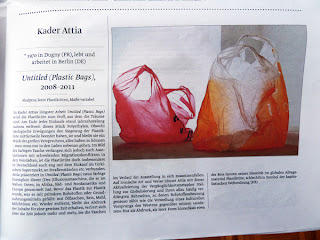It has been
a long time since I promised I would post an English version of my method of
ice-cube dyeing that was published in the July edition of the
Patchwork-Professinal magazine last year. Here it comes!
When you
try this, you will get fantastic results in terms of color dispension and
patterns –each one a unique piece. Don’t start with small pieces of fabric, as
you will want to have more to work with!
I’m
assuming that you know how to dye fabrics with ProcionMX dyes, the basics, security
issues, materials and concentrations.
First, resoak
your pfd-fabric in soda ash and let it dry on rack, hanging. That way you will
get your fabric to be sufficiently flat.
Then mix your color. For a piece of fabric approx. 44 x 65 inch I mix a total of about three-fourths
of a litre of colour. This solution is put into ice-cube trays (I have four
trays, just enough for the amount of liquid) and these go into the freezer.
Make plenty of room away from your food items in the freezer, and be careful
when you put it in so you don’t spill anything. Because it will freeze right
away and you don’t want to have to defrost your freezer to clean it all off.
(Believe me, I learned the hard way...)
Cover a
large table with plastic sheets so its surface is protected. I use cover sheets
from operating rooms which I get from a friend who is a nurse.
When your ice-cubes are ready, spread the fabric onto the plastic covered table. I usually put it in at least three, sometimes even four layers. That way the lower layers will soak up melting water which a single layer would not be able to take in by itself. Noticeable results will be appearing unto as low as the third layer, perhaps even the fourth layer, anything below that will definitely require further treatment, but save you some mess...
Take the
ice cubes out of the tray and spread them sort of evenly across the fabric.
When
rinsing the ice-cube-trays, try to catch the water in a little bucket – you can
either freeze it for another, lighter shade, or save it for a later step as
described below.
Let the
ice-cubes melt. Because the fabric has been soaked in soda ash a fixing is not
needed anymore.
 |
| Melted.... |
Check your
result. If you find it has too many white spots, dry it on the rack and then
put on another layer of ice-cubes, either a different color, or the ice cubes
you made from the excess water when rinsing the trays as mentioned above. Or,
if you did not freeze the leftover water, you could put the piece of fabric
into the excess water in a bucket. Or you can paint into the white spots with
foam brushes. ... Or...
Different mixtures will show a different appearance after melting. Here is a comparison between 'orange' and 'bronze'.
These
were the second and third layers under 'bronze' above, subsequently overdyed with yellow ice-cubes (probably layer 3 and 4, can't exactly remember).
In this following series you can
see how a fabric will change with repeated applications. This is the result of a first application of blue ice-cubes.
This is the result of a
second application, this time yellow ice-cubes. There were still a few white
spots left.
So a
third application took care of those.
Have fun experimenting!
















